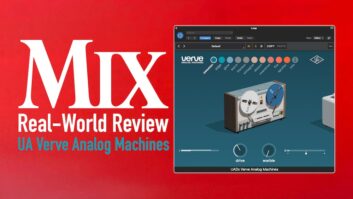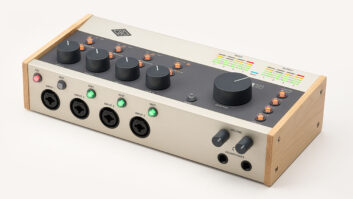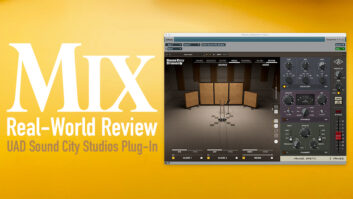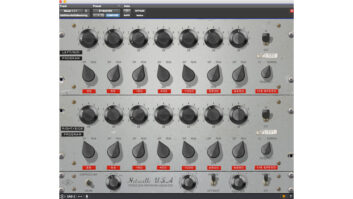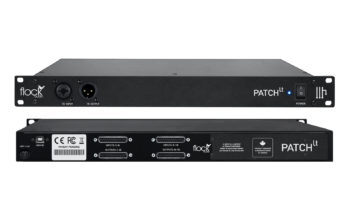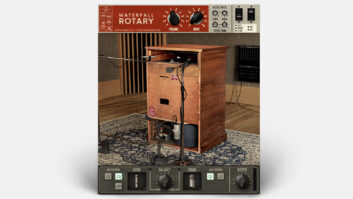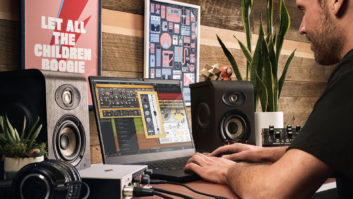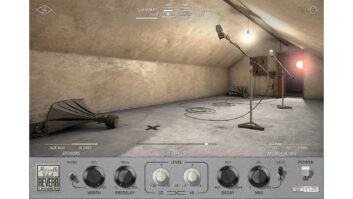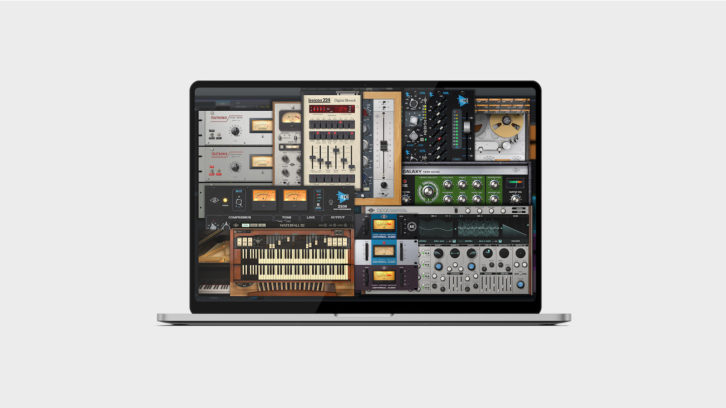
Universal Audio is the latest music software developer to jump into the subscription market. Its new Spark plan includes 17 plug-ins, of which 13 are processors, including three variations each of the Teletronix LA-2A and UREI 1176 compressors. You also get four instruments, and all but one of the included plug-ins are versions of existing UAD products.
What makes Spark newsworthy is that the plug-ins are the company’s first 100 percent native offerings. Right now, Spark is only for Mac, but Universal Audio says a Windows version is in the pipeline for this Fall.
Spark offers an opportunity to access UAD plug-ins for a much lower upfront cost than ever. Previously, any UAD system required one of the company’s interfaces or accelerator units. Then you’d need to buy plug-ins if you wanted a similar variety to what comes in Spark (UAD does include a small plug-in bundle with hardware purchases). All told, the system would cost several thousand dollars, depending on the interface or accelerator you chose.
Flare Calmer Earplugs – A Real-World Review
Onkart Gromt Grompressor – A Real-World Review
Audio Ease Altiverb 7 – A Real-World Review
But a Spark subscription costs less than $20 per month and requires no hardware purchase—you bring your own interface. Such is the appeal of the subscription model: You get more for your money, albeit without ownership.
The release of Spark also means that users can buy one of UAD’s new Volt interfaces—which don’t support UAD’s hardware-accelerated offerings—and still be able to access at least a subset of the company’s plug-ins.
According to Universal Audio, Spark is “an evolving collection” with an “ever-expanding library.” I asked the company to provide more specifics about how many plug-ins it would add in the coming year and which ones. They couldn’t offer specifics but certainly reiterated that the collection will continue to expand. Let’s look at the current lineup that you get with a Spark subscription.
THE BIG SQUEEZE
On the Spark page of its website, Universal Audio breaks down the Spark plug-ins (which have a UADx prefix to distinguish them from the hardware-accelerated UAD plug-ins) into four categories.
One of the categories is Compressors, and you get several. That’s not surprising, as Universal Audio is known for its emulations of vintage compressors. The subscription includes the Teletronix LA-2A Collection, which features three variations of the classic Teletronix Leveling Amplifier, the LA-2, LA-2A Gray and LA-2A Silver. For controlling dynamics and adding a little tube warmth, these authentic-sounding LA-2A plug-ins are excellent.
Also included is the UADx version of the UA 1176 Collection, which features three variations of the classic 1176 FET compressor: the 1176 Rev A, 1176AE and 1176LN Rev E. You also get UADx API 2500 Bus Compressor plug-in. Not to take anything away from that plug-in, but I would have preferred the SSL G Bus Compressor, which is another UAD staple.
SPACE IS THE PLACE
The Reverbs and Delays category of Spark features three excellent plug-ins. The Lexicon 224 is an awesome-sounding digital reverb that includes a range of algorithms, including halls, plates and chambers, and offers real adjustability. Another, Pure Plate Reverb, combines a simple user interface with up to 5.5 seconds of lush plate reverb.
For delay, Spark offers the Galaxy Tape Echo, an emulation of the Roland RE-201 Space Echo. It provides both tape delay and spring reverb emulations. It’s an excellent plug-in, but if I were choosing a delay plug-in from the UAD catalog to include with Spark, I would have picked the UAD EP-34 (an EchoPlex emulation).
BEFORE AND AFTER
The Preamps, EQ and Tape category includes three plug-ins. One is the classic Neve 1073, which contains a preamp and three-band active EQ. Another is the API Vision Channel Strip Plus, which UAD modeled from the 200 and 500 Series modules used in the channel strips of the API Vision console. These include the 212L Microphone Preamp, 215L High/Low Sweep Filters, the 225L Compressor Limiter, 235L Gate/Expander and 550L Four-Band Equalizer, which you can swap with the 560L Ten-Band Graphic Equalizer. Also included is the Studer A800 Tape Machine, which allows you to apply tape-like tone and saturation to sources.
PLAYING IT RIGHT
Of the four virtual instrument plug-ins in Spark, three were initially developed by Universal Audio for its Luna DAW. Of those, one is a replication of the Moog Minimoog Model D that sounds as good or better than any virtual Minimoog I’ve ever used. The analog modeling in it is exceptional.
You also get the Waterfall B3, a gorgeous-sounding emulation of a Hammond B3 and a Leslie rotating speaker in one plug-in. UAD meticulously replicated the B3 and even included virtual bass pedals accessible from your controller on a separate MIDI channel. The Leslie features speed and overdrive controls, along with adjustable mic positions and switchable virtual models for stereo mics on the Horn and a mono mic on the Drum.
The Ravel Grand Piano is a sweet-sounding modeled Steinway Model B grand piano that gives you virtual close mics and room mics. It has a simple user interface that allows for changing the balance between the two mic types, adjusting dynamics and tone, and even choosing reverse piano samples.
A SYNTH GEM
The last of the four instruments, the Opal Morphing Synthesizer, is original for UADx and only available for Spark subscribers. UA refers to it as an “analog-meets-wavetable” synth because you can set each of its three oscillators to use modeled analog or wavetable sound sources (it also offers a Noise Generator).
Each oscillator has a Morphing Dial that lets you adjust its waveshape. If you set an oscillator to Analog, you can morph it between all the available analog waveforms, including sine, triangle, sawtooth and square.
If you choose Wavetable, you first select from an extensive list of wavetables in five categories: Digital, Synth, Complex, Vocal/Vowel and Instrument. You can then morph it between different waveforms in the selected wavetable. The ability to morph oscillator waveshapes adds tons of creative possibilities with the instrument.
The output of the oscillators and noise generator goes through a mixer, after which you can apply filters and various types of modulation. At the output stage, you can add two additional effects from a list that includes Reverb, Delay, Harmonic (distortion and overdrive), Modulation and EQ/compression. Of course, if you’re not into programming or tweaking, the instrument features a generous selection of presets that you can search by Genre, Type or Description.
It’s quite a versatile synth overall. Whether you’ve dialed up a patch with analog or digital waveforms (or a combination), it sounds rich and authentic and should be handy for any musical style that uses synths.
PRESS AND GO
Once you’ve subscribed to Spark, downloading and installing the plug-ins requires a different process than with standard UAD plug-ins. You begin by downloading an installer application called UA Connect. Once open, you see screenshots of all the Spark plug-ins, each with an Install button.
The UADx plug-ins look almost identical to their UAD counterparts, except they include a new design and placement for the preset management features, which are located on the top of the GUI rather than the bottom. The way UADx handles presets is efficient and reminiscent of the browsers in Luna. They not only include search functions but the ability to mark a preset as a “Favorite.”
When I put corresponding UAD and UADx plug-ins side by side, they mostly looked alike (other than the preset handling differences), but the graphics were sharper in some of the UADx plug-ins, such as the Lexicon 224 and the Studer A800. I also noticed that the UADx Studer A800 didn’t include the Gang feature from the UAD version, which lets you apply settings on one instance across any other open instances. Universal Audio told me that the specs are the same between corresponding UAD and UADx plug-ins. When I compared them to each other, I couldn’t hear any difference.
WHAT TO THINK?
I’m quite impressed with Spark overall. My only criticism of any substance is about the decision to include all three variations each of the 1176 and the LA-2A. To me, that seems redundant. For variety, I would have preferred only one 1176 and one LA-2A and some different processors in place of the alternate versions.
That said, my guess is that Spark will be quite popular and very competitive with other subscription programs. It may not offer the number of plug-ins you can get elsewhere, but the ones it does provide are revered among professionals and come from the higher end of the market in both price and quality. Software subscriptions are all about value, and Spark delivers it big time.
PRODUCT SUMMARY
COMPANY: Universal Audio
PRODUCT: Spark
WEBSITE: spark.uaudio.com
PRICE: $599
PROS: Native UADx plug-ins. UADx performance. Excellent value. Low price. Redesigned preset browsers. Four excellent instruments. New and exclusive Opal Morphing Synthesizer.
CONS: Three versions each of LA-2A and 1176 redundant in a small collection. No specifics on future expansion.
